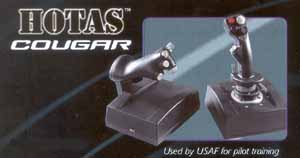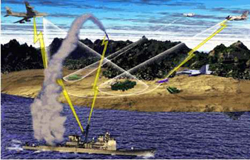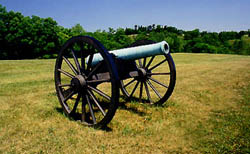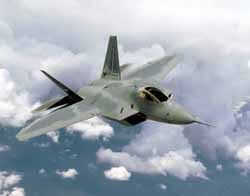Page 1
Daily News
By Gail Helmer
| Send Us News | Archives | Main |
Wednesday September 19, 2001
- Commandos 2: Men of Courage Ships
- USAF Selects HOTAS Cougar
- Northrop Grumman Selected For Next Phase Of AMSTE
- Boeing Responds to Current Business Environment
- Heroes Saved Lives In Pentagon Fire
- Air Force Won't Repeat Past Mistakes Of Strategy
PC News
Commandos 2: Men of Courage Ships
Eidos Interactive has announced that its latest strategy game, Commandos 2: Men of Courage, has shipped to stores and should arrive on Thursday, September 20. Commandos 2 is the sequel to Commandos: Behind Enemy Lines.
Commandos 2 is a tactical action/strategy game set against the backdrop of World War II. The player takes control of an elite group of commandos who must venture deep into enemy territory to complete a series of mission-based objectives in an attempt to change the course of the war.
USAF Selects HOTAS Cougar
The HOTAS Cougar has been selected by the USAF for pilot training. In August, the prototype of the HOTAS Cougar successfully passed testing by the USAF.
"Those factors have slowed a bit of our developpement, but I am very proud of that, for the development team, it's an incredible label of quality", says Guillaume Lelevé, Product Manager.
Other organizations, including Lockheed Martin, have also expressed interest in the HOTAS Cougar. The HOTAS Cougar from Thrustmaster is a state-of-the-art joystick. The stick and throttle are replicas of the real american fighter F16 Block 52 Controller, with die Cast (metal) base, handle buttons and gimbals. Advanced hardware keyboard and mouse generation with user friendly programming Windows interface by Dr. James Hallows.
Military News
Northrop Grumman Selected For Next Phase Of AMSTE
Northrop Grumman Corporation has been selected to demonstrate the next phase of the Defense Advanced Research Projects Agency's (DARPA) Affordable Moving Surface Target Engagement (AMSTE) program.
The project is funded by DARPA's Special Projects Office in conjunction with the U.S. Air Force Research Laboratory in Rome, N.Y. Northrop Grumman's Integrated Systems sector is conducting the project through its Airborne Ground Surveillance and Battle Management (AGS&BM) Systems business area here. Terms and scope of the contract were not disclosed.
The purpose of the AMSTE program is to develop a system that locates and tracks a ground target moving at up to 50 m.p.h. and destroy it with an affordable precision weapon. This technology makes it possible for commanders to conduct multiple, near simultaneous, stand-off precision engagements of even the most mobile targets in all weather.
"This announcement validates the leadership position we enjoy in integrating system-of-systems to achieve critical results at reasonable cost on the advanced battlefield," said Ralph D. Crosby Jr., corporate vice president and president of Integrated Systems. "Demonstrating the know-how to kill movers based on real-time, stand-off intelligence is the fulfillment of the long-held promise of integrated surveillance and precision strike."
In August, the Northrop Grumman team successfully demonstrated the capability to precisely engage a moving target with a seeker-less weapon. The test, conducted in overcast conditions at Eglin AFB, Fla., scored a direct hit through the top center of a moving vehicle on the first try.
Key to this success was excellent system performance afforded by the Joint Surveillance Target Attack Radar System (Joint STARS), which provided continuous in-flight target updates to a Lockheed Martin seeker-less weapon.
Updates were based on advanced fusion tracking of precise ground moving target indicator radar data from Joint STARS and the Lockheed Martin Joint Strike Fighter team radar sensor mounted on the Northrop Grumman flight test aircraft. This system-of-systems will be further enhanced in the next phase by adding the Global Hawk unmanned aerial vehicle system to the intelligence-surveillance-reconnaissance mix.
"This new technology will provide the warfighter with an unprecedented capability to deny adversaries sanctuary of movement. It enables precision engagement of moving targets from stand-off ranges in all weather using low-cost unitary weapons, minimizing the risk of collateral damages," said Bill McCall, senior program manager at Integrated Systems. "With our teammates, we will build on our successful system-of-systems design in the next phase to demonstrate increased levels of difficulty associated with tracking ground targets."
Boeing Responds to Current Business Environment
Boeing is taking a series of actions to address the changed business environment in light of last week's terrorist attacks against the United States.
Given the impacts of the horrific attacks of September 11, and the resulting capacity reductions now anticipated by its airline customers, Boeing's Commercial Airplanes unit is setting in place plans to reduce its employment by approximately 20,000 to 30,000 people by the end of 2002. This includes a reduction in related support personnel at Boeing's Shared Services Group.
"We profoundly regret that these actions will impact the lives of so many of our highly-valued employees," said Alan Mulally, president and CEO of Boeing Commercial Airplanes. "However, it is critical that we take these necessary steps now to size the Commercial Airplanes business to support the difficult and uncertain environment faced by our airline customers."
Revised delivery projections for Boeing Commercial Airplanes, which are assessments based on an uncertain future and depend upon customer business decisions, are as follows: Deliveries for 2001, which had been expected to be 538 aircraft, could be as low as 500 depending on customer ability to take delivery in the near term. For 2002, deliveries are estimated to be in the low 400s, compared to the 510 to 520 previously forecast. Current estimates for 2003 indicate a downward delivery trend will continue. Boeing will add further clarity about 2003 as it gains insight into the market's direction. These estimates are in line with the initial 20 percent capacity reduction projections provided by U.S. carriers and its assessment of world airline traffic trends.
The company is working closely with the government on improving air transport safety and security. It has also launched an internal initiative under the direction of its chief technology officer to solicit and review ideas from Boeing engineers for improving these areas. At the same time, the company is working to apply its extensive capabilities in intelligence gathering, communications and space, as well as military aircraft and missiles, in the war against terrorism.
"The company is ready to apply all of its wide-ranging technological resources in stepping up to the challenges created by these tragic events," said Boeing chairman and CEO Phil Condit. "We are making tough business decisions and working closely with our commercial and government customers to rebuild public confidence in a safe and secure U.S. air transport system.
"These actions will also enhance the company's ability to maintain its solid financial position, strong liquidity and premier debt ratings. These are critical factors in times of business uncertainty and financial stress," Condit said.
America's New War
Heroes Saved Lives In Pentagon Fire
The casualty toll at the Pentagon last week may have been much worse, officials said, if it wasn't for the heroic actions of many soldiers and civilian employees.
"There were an unknown number of acts of personal courage and heroism," said Brig. Gen. Clyde A. Vaughn, deputy director of military support to civil authorities.
Vaughn said he was returning to the Pentagon Sept. 11 when he saw a Boeing 757 slam into the west side of the building. He saw people coming out of the building limping badly, he said, "and every one of them had two or three people caring for them and comforting them."
Lt. Col. Ted Anderson carried two of the injured away from the burning building. Then he re-entered the smoke-filled Pentagon through a broken window to drag out two more injured employees, one whose clothes were on fire.
Anderson kicked open an interior door and with the help of two others, carried a heavy woman out of the building and boosted her through the broken window. Then back inside a dark corridor, Anderson said he saw a flash go by and realized a man's clothes were on fire. He tackled the employee and rolled him on the ground to extinguish the flames.
After helping the burn victim out through the window, Anderson turned to go back in again, but was stopped by two firemen who grabbed his shoulders and struggled to keep him from returning into the flames that had ignited from the jet fuel. Anderson said he was upset with the firemen for not letting him go back.
"You don't leave your comrades on the battlefield," said Anderson, a field artillery officer who worked in the Office of the Chief of Legislative Liaison. "To me, this was the battlefield."
Brig. Gen. Glenn Webster, director of Training in the Office of the Deputy Chief of Staff for Operations and Plans, was in the section of the building one floor above where the plane hit. He and most of his staff were able to get downstairs and outside before the floor caved in.
Everybody moved quickly into the hallway, Webster said, and then a fireball shot forward along the suspended ceiling. Chunks of the suspended ceiling began to fall, he said, as soldiers checked stairwells for heat and smoke to find the safest way out. He said a few others actually ran atop part of the burning aircraft to get out.
"Soldiers were helping badly burned and cut personnel out of the building," Webster said. He said other soldiers used debris to break windows open and pull people out.
A contract employee who worked with Webster, retired Sgt. Maj. Ron Schexnayder, went back upstairs to get a flashlight to help guide people out.
"All the lights went off immediately after the big explosion," Schexnayder explained. He moved debris out of the way so people could get through.
Once outside, Webster helped perform first aid on a number of the fire victims. He treated them for shock by loosening clothing, removing shoes, propping up their feet and covering them with whatever he could find. He helped a nurse and medic triage the victims and held an IV bag for one patient.
Spc. Beau Doboszenski also helped provide first aid to the injured immediately following the plane crash.
A soldier with B. Co., 3rd U.S. Infantry, Doboszenski had been trained as an emergency medical technician before joining the Army. He served as a volunteer firefighter and EMT in Loretto, Minn., before enlisting.
"I come from a family of fire fighters," Doboszenski said.
Doboszenski was working in the Pentagon as a tour guide the morning the aircraft struck the building. The Tour Guide office is on the opposite end of the building from where the plane hit, so Doboszenski didn't even hear the explosion. But he heard a Navy captain screaming for anyone with medical training.
Doboszenski ran around the building, was stopped by police, so he went around barricades and ran down the George-Washington Parkway. He reached Pentagon North Parking where medics from the health clinic were beginning to perform triage on victims of the blast and fire. He joined in to help.
He treated a woman who was having trouble breathing and placed a tube down her throat. Then he helped load the woman and about 20 others who were injured into automobiles so they could be taken to a nearby hospital.
Doboszenski then went with a six-man team into the building where the fire was still blazing. They placed doused rags around their faces and spent an hour in calf-deep water searching for survivors.
Air Force Won't Repeat Past Mistakes Of Strategy
The Air Force's top officials pledged Sept. 17 that the service would not repeat the mistakes of strategy that led to the nation's greatest single loss of life on a battlefield -- a battle which took place more than a century ago.
Secretary of the Air Force Dr. James G. Roche and Air Force Chief of Staff Gen. John P. Jumper made their remarks during an Air Force re-enlistment ceremony at the Pentagon. Fifty-four airmen took part in the ceremony, symbolizing the service's 54th birthday.
"I don't think you could have picked a more momentous time to re-enlist," Roche said. "Today marks the 139th anniversary of the (Civil War) battle of Antietam. What's interesting about that battle that's timely for today is it remains the greatest single loss of American life in battle."
Of the roughly 23,000 casualties, about 3,000 Americans lost their lives. Many of those losses were because of mistakes in leadership.
Photo by Ralph Blodgett
"It was an example of not understanding the technology of war," Roche said. "War had changed, but the leaders didn't know how to adapt to new technology. They didn't know how to adapt to how war had to be fought (in those conditions) compared to the way they'd always done it." Roche said that the terrorist attacks Sept. 11 were a wake-up call to America's military of today.
"It's a signal that war in the future will not be like war in the past," Roche said. "But unlike the officers of Antietam, this Air Force is open. It's willing to listen. It believes in challenging up and recognizes that many of you are the key to our future."
Roche said Air Force leadership needs to rethink how aerospace power will affect the future of war -- a war that is protracted, and one where there's no other air force to take on.
"There is no canopy-to-canopy thinking," he said.
Noting the Air Force's relatively short history compared to America's other armed forces, Jumper reflected upon the service's heroic past.
"We've made our mark," he said. "We grew up with heroes -- astronauts, aces and Medal of Honor winners. And we have our heroes from the 11th of September."
Those heroes include Air Force Reserve Maj. Leroy Homer, a pilot aboard hijacked United Airlines Flight 93. "We know there was a struggle aboard that aircraft," Jumper said. "We like to think that people in uniform tried to retake control of that aircraft and save many more lives on the ground.
"Those heroes, and the heroes who gave their lives in (the Pentagon), the World Trade Center, the firefighters and policemen, are all with (us) today," he said. "They are waiting to judge our actions. Will they be worthy of the sacrifices that have been made? Not for retribution or revenge, but for justice -- justice that's borne of a righteous cause.
"As the president of the United States said, 'this is not for the short-term, but the long-term'," Jumper said. "The heroes that are (here) today will approve."
| Send Us News | Archives | Main |



